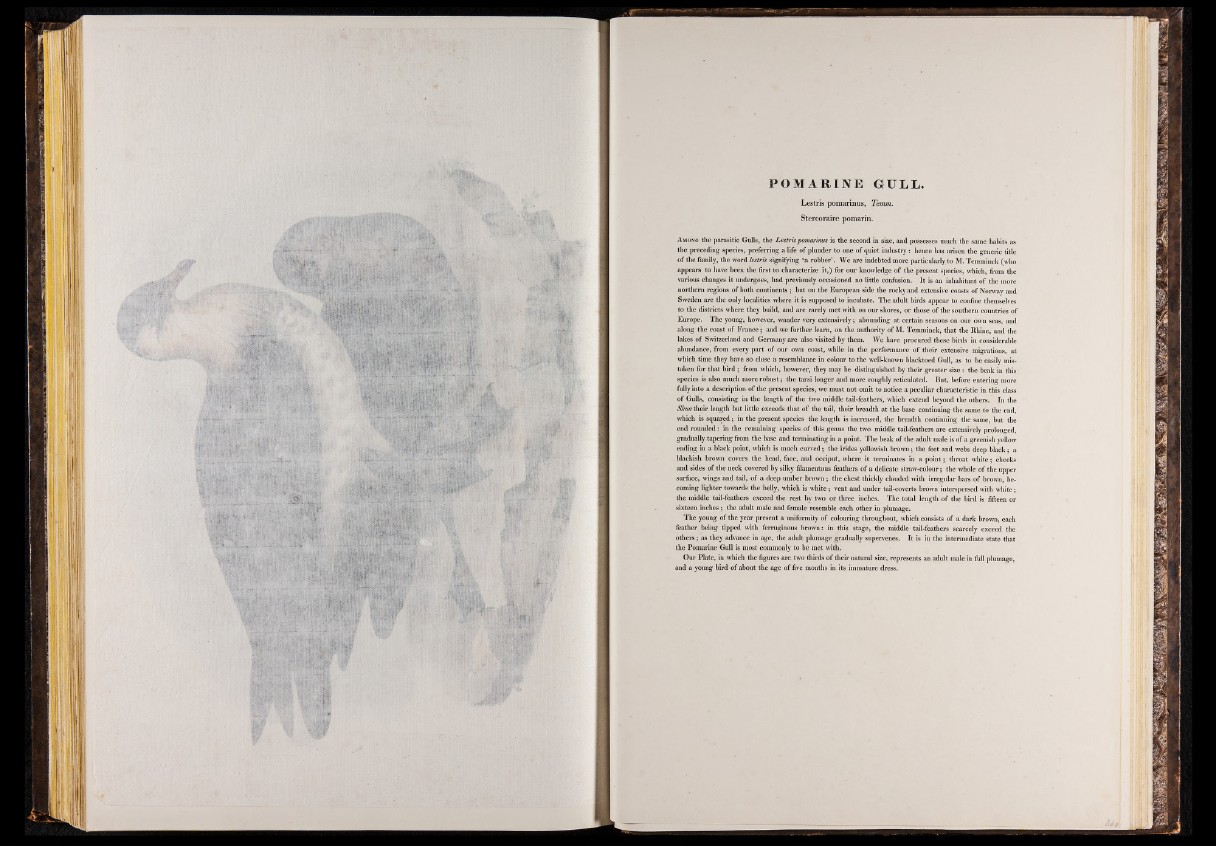
a
1
POMA R IN E GULL.
Lestris p omarinus, Temm.
S te rco raire pomarin.
A mong the parasitic Gulls, the Lestris pomarinus is the second in size, and possesses much the same habits as
the preceding species, preferring a life of plunder to one of quiet industry: hence has arisen the generic title
of the family, the word lestris signifying ‘a robber’. We are indebted more particularly to M. Temminck (who
appears to have been the first to characterize it,) for our knowledge of the present species, which, from the
various changes it undergoes, had previously occasioned no little confusion. It is an inhabitant of the more
northern regions of both continents ; but on the European side the rocky and extensive coasts of Norwav and
Sweden are the only localities where it is supposed to incubate. The adult birds appear to confine themselves
to the districts where they build, and are rarely met with on our shores, or those of the southern countries of
Europe. The young, however, wander very extensively; abounding at certain seasons on our own seas, and
along the coast of France; and we further learn, on the authority of M. Temminck, that the Rhine, and the
lakes of Switzerland and Germany are also visited by them. We have procured these birds in considerable
abundance, from every part of our own coast, while in the performance of their extensive migrations, at
which time they have so close a resemblance in colour to the well-known blacktoed Gull, as to be easily mistaken
for that bird ; from which, however, they may be distinguished by their greater size : the beak in this
species is also much more robust; the tarsi longer and more roughly reticulated. But, before entering more
fully into a description of the present species, we must not omit to notice a peculiar characteristic in this class
of Gulls, consisting in the length of the two middle tail-feathers, which extend beyond the others. In the
Skua their length but little exceeds that o f the tail, their breadth at the base continuing the same to the end,
which is squared; in the present species the length is increased, the breadth continuing the same, but the
end rounded: in the remaining species of this genus the two middle tail-feathers are extensively prolonged,
gradually tapering from the base and terminating in a point. The beak of the adult male is of a greenish yellow
ending in a black point, which is much curved; the irides yellowish brown; the feet and webs deep black; a
blackish brown covers the head, face, and occiput, where it terminates in a point; throat white; cheeks
and sides of the neck covered by silky filamentous feathers of a delicate straw-colour; the whole of the upper
surface, wings and tail, of a deep umber brown; the chest thickly clouded with irregular bars of brown, becoming
lighter towards the belly, which is white; vent and under tail-coverts brown interspersed with white;
the middle tail-feathers exceed the rest by two or three inches. The total length of the bird is fifteen or
sixteen inches; the adult male and female resemble each other in plumage.
The young of the year present a uniformity o f colouring throughout, which consists of a dark brown, each
feather being tipped with ferruginous brown: in this stage, the middle tail-feathers scarcely exceed the
others; as they advance in age, the adult plumage gradually supervenes. It is in the intermediate state that
the Pomarine Gull is most commonly to be met with.
Our Plate, in which the figures are. two thirds of their natural size, represents an adult male in full plumage,
and a young bird o f about the age of five months in its immature dress.